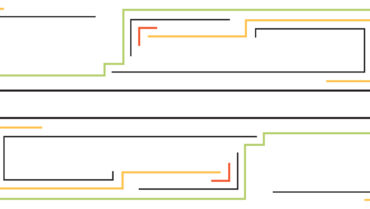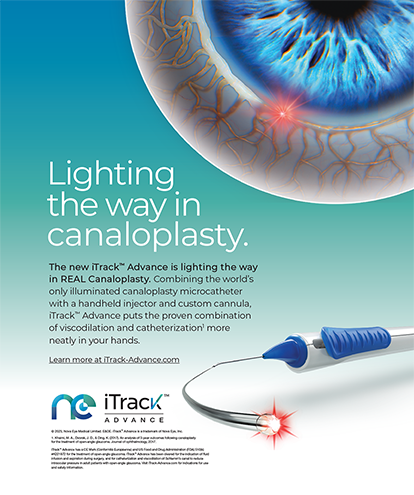
Every cataract surgeon will perform an IOL exchange at some point. The aim is to perform the procedure only when it’s necessary. Preparation, including an accurate IOL power calculation, is crucial for an IOL exchange.
WHEN TO EXCHANGE THE LENS
Malpositioned IOL. If the IOL has moved out of its intended position, then it likely does not need to be exchanged. Ideally, the same IOL can be repositioned in the capsular bag, or the IOL and/or capsular bag complex can be fixated to the iris or scleral wall with sutures. If the first IOL cannot be used, a replacement IOL of the same design and power is typically preferred if the patient was otherwise happy with their visual outcome.
Refractive surprise. Despite precise and laborious preoperative planning, some patients will have a refractive surprise after cataract surgery. This can be due to a variety of factors including poor preoperative measurements from an unstable ocular surface or calculation errors, postoperative cystoid macular edema, or an unexpected effective lens position (ELP).
Before the IOL is exchanged, check to make sure that the patient’s ocular surface is optimized and there is no anterior or posterior segment pathology to explain the unexpected refractive outcome. If the patient has persistent blurred vision with a reproducible residual refractive error, an IOL exchange can be considered. If posterior capsular opacification is present, I try to delay an Nd:YAG capsulotomy. If an IOL exchange is needed, the laser treatment can limit the lens options.
I typically consider a laser vision correction enhancement for less than 1.00 D of hyperopia and 2.00 D of myopia. The risk of corneal aberrations and decreased image quality increases with the amount of ablated corneal tissue, especially with diffractive IOL technologies. Additionally, an IOL exchange may be preferable even for lower degrees of residual refractive error in eyes with abnormal corneal architecture such as thin pachymetry or a slight irregularity of the corneal contour.
I wait at least 1 month after a refractive surprise to ensure normal postoperative healing (eg, corneal edema, anterior chamber inflammation, macular edema). If the biometry, topography, and refraction measurements have changed significantly, then I redo the IOL calculations to determine if a different IOL power is proposed. I also consider the refractive outcomes from the initial surgery and perform back-calculations. For instance, if the original IOL power resulted in a myopic overcorrection of 1.00 D and new measurements proposed the same IOL power, I would consider implanting an IOL with 1.00 D less power to avoid another myopic surprise. In contrast, if an IOL resulted in a hyperopic overcorrection of 1.00 D, I would consider implanting an IOL with 1.00 D more power to avoid another hyperopic outcome. Shortcuts for a bag-to-bag IOL exchange are the following:
- Multiply the postoperative refractive error spherical equivalent by 1.2 for a myopic error and subtract it from the original IOL power to obtain the new IOL power; or
- Multiply the postoperative refractive error spherical equivalent by 1.5 for a hyperopic error and add it to the original IOL power to obtain the new IOL power.1
The Barrett RX formula can be used to determine the IOL power for an IOL exchange or a piggyback IOL. The original IOL model and power, new IOL model and power, postoperative refractive outcome, and repeat biometric data are used to help predict the new power of the IOL. For toric IOLs, the Barrett Universal II formula and the Barrett Toric Calculator are used to determine whether the IOL should be exchanged or rotated and to calculate the degree of rotation to improve the postoperative refractive result.
The Berdahl-Hardten Toric Results Analyzer is another tool to assist in planning a postoperative toric IOL rotation or IOL exchange. The analyzer helps surgeons manage residual astigmatic refractive errors after the placement of a toric IOL. The original IOL model and power, new IOL model and power, biometric data, and intended postoperative refraction are used by the calculator to determine how much rotation of the lens is needed to achieve the lowest amount of residual astigmatism. It also determines whether changing the spherical and/or toric power of the IOL should improve the postoperative refractive outcome.
Lastly, intraoperative aberrometry is useful to provide an aphakic measurement and indicate if the new IOL would result in the intended refractive outcome. Adjustments can be made as needed.
Dislocated IOL. If the original IOL is dislocated and cannot be refixated, secondary IOL fixation is required. My preferred method is intrascleral haptic fixation of a CT Lucia 602 IOL (Carl Zeiss Meditec). Other surgeons commonly use the ZA9003 and AR40e Sensar (both from Johnson & Johnson Vision).
IOL calculation for a dislocated IOL is challenging. The postoperative ELP depends on a multitude of variables, including the distance of sclerotomies from the limbus (2 vs 2.5 mm), the white-to-white distance of the eye, and the length of the haptics after they are trimmed and cauterized. Colleagues from Baylor have shown that aiming for 0.50 to 0.75 D of myopia can reduce the likelihood of a hyperopic outcome in these cases.2
Biometry and topography must be repeated to calculate the new IOL power. These measurements and the appropriate A constant are plugged into the Barrett Universal II online calculator, and the IOL power closest to 0.50 to 0.75 D of myopia is chosen. I always counsel patients that, because of an inherent degree of unpredictability in these calculations, they may need glasses for distance and near vision after surgery.
Other methods of secondary IOL fixation include gluing or suturing the IOL to the scleral wall and iris fixation. Regardless of the chosen technique, I perform IOL calculations similarly. For a suture-fixation technique, I err on the side of slight myopia to avoid a postoperative hyperopic surprise. For an iris-fixation technique, I aim for the sulcus equivalent. A more anterior ELP renders the IOL power stronger.
Positive and negative dysphotopsias. Patients who experience positive or negative dysphotopsias often require additional chair time to temper their expectations for an IOL exchange procedure. Positive dysphotopsia cases typically require exchanging the IOL for a different lens design (eg, changing from a multifocal/trifocal diffractive IOL to a monofocal IOL; changing from an IOL with a square-edge design to an IOL with a round-edge design; or switching to an IOL with a lower index of refraction). Negative dysphotopsias can be improved with a variety of methods including reverse anterior optic capture, sulcus IOL placement, or placement of a piggyback IOL (for more on piggyback IOLs as an alternative strategy, see “Alternative Options: When and Why?").3
For positive and negative dysphotopsias, IOL calculation methods can be used for bag-to-bag exchange using the A constant of the new IOL platform. If, however, a posterior capsular defect such as after Nd:YAG capsulotomy is present, a three-piece IOL should be fixated in the sulcus. If optic capture is to be performed, the IOL power should be equivalent to if the IOL were placed in the capsular bag. If the IOL is to be placed in the sulcus, calculate the sulcus equivalent by subtracting 0.50 to 1.50 D from the in-the-bag IOL measurement depending on the IOL power.
If reverse optic capture is performed, the patient should be counseled that the postoperative refractive error can change owing to the altered ELP of the IOL.
CONCLUSION
An IOL exchange requires extensive planning. Be meticulous with your preoperative measurements, understand the patient’s anatomy and visual needs, and be prepared to perform your IOL exchange technique of choice with the properly calculated IOL. Studies have shown that IOL exchanges can be performed safely with good visual outcomes using various types of IOLs (see Always Have a Back-Up).4
Always Have a Back-Up
For any IOL exchange case, it is important to come to the OR with an arsenal of differently powered lenses for in-the-bag placement, sulcus placement, scleral fixation, and iris fixation. It is also advisable to have an anterior chamber IOL ready to use.
1. Hillman L. IOL exchange for the young eye surgeon. Eyeworld. January 2018. Accessed January 12, 2023. https://www.eyeworld.org/2018/iol-exchange-for-the-young-eye-surgeon/
2. McMillin J, Wang L, Wang MY, et al. Accuracy of intraocular lens calculation formulas for flanged intrascleral intraocular lens fixation with double-needle technique. J Cataract Refract Surg. 2021;47(7):855-858.
3. Masket S, Fram NR. Pseudophakic dysphotopsia: review of incidence, cause, and treatment of positive and negative dysphotopsia. Ophthalmology. 2021;128(11):e195-e205.
4. Kim EJ, Sajjad A, Montes de Oca I, et al. Refractive outcomes after multifocal intraocular lens exchange. J Cataract Refract Surg. 2017;43(6):761-766.




